1997 TOYOTA LAND CRUISER stop start
[x] Cancel search: stop startPage 38 of 159
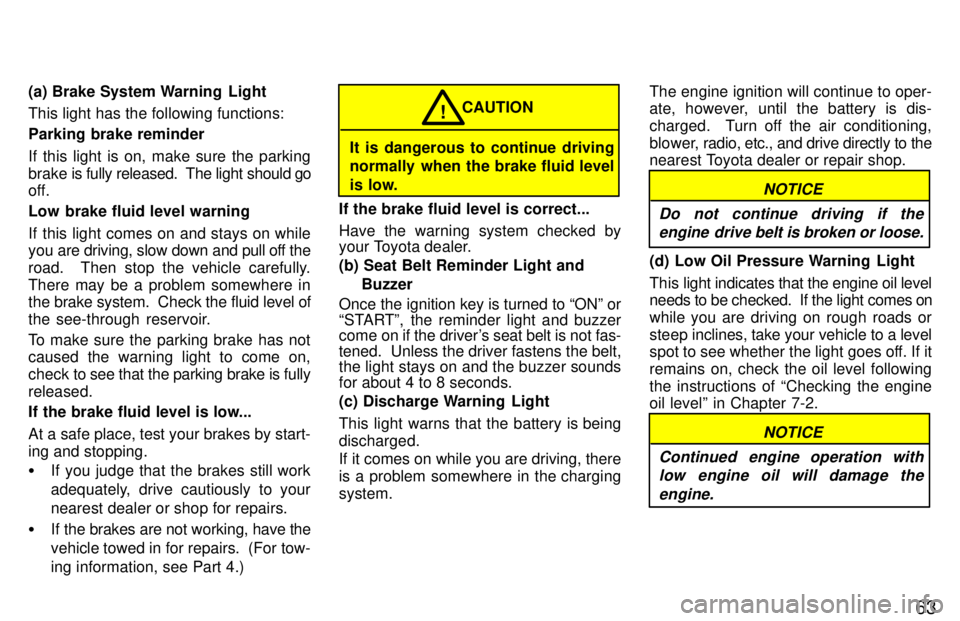
63
(a) Brake System Warning Light This light has the following functions: Parking brake reminder
If this light is on, make sure the parking
brake is
fully released. The light should go
off.
Low brake fluid level warning
If this light comes on and stays on while
you are driving, slow down and pull off the
road. Then stop the vehicle carefully.There may be a problem somewhere in
the brake system. Check the fluid level of
the see-through reservoir.
To make sure the parking brake has not
caused the warning light to come on,
check to see that the parking brake is fully
released.
If the brake fluid level is low...
At a safe place, test your brakes by start-
ing and stopping. � If you judge that the brakes still work
adequately, drive cautiously to yournearest dealer or shop for repairs.
� If the brakes are not working, have the
vehicle towed in for repairs. (For tow-
ing information, see Part 4.)
It is dangerous to continue driving
normally when the brake fluid level
is low. CAUTION
!
If the brake fluid level is correct...
Have the warning system checked by
your Toyota dealer. (b) Seat Belt Reminder Light and Buzzer
Once the ignition key is turned to ONº or
STARTº, the reminder light and buzzer
come on if the driver's seat belt is not fas- tened. Unless the driver fastens the belt, the light stays on and the buzzer sounds for about 4 to 8 seconds.
(c) Discharge Warning Light
This light warns that the battery is being discharged.
If it comes on while you are driving, there
is a problem somewhere in the chargingsystem. The engine ignition will continue to oper-
ate, however, until the battery is dis-
charged. Turn off the air conditioning,
blower, ra
dio, etc., and drive directly to the
nearest Toyota dealer or repair shop.
NOTICE
Do not continue driving if the engine drive belt is broken or loose.
(d) Low Oil Pressure Warning Light
This light indicates that the engine oil level
needs to be checked. If the light comes on
while you are driving on rough roads orsteep inclines, take your vehicle to a level
spot to see whether the light goes off. If itremains on, check the oil level followingthe instructions of Checking the engine
oil levelº in Chapter 7-2.
NOTICE
Continued engine operation with low engine oil will damage the
engine.
Page 39 of 159
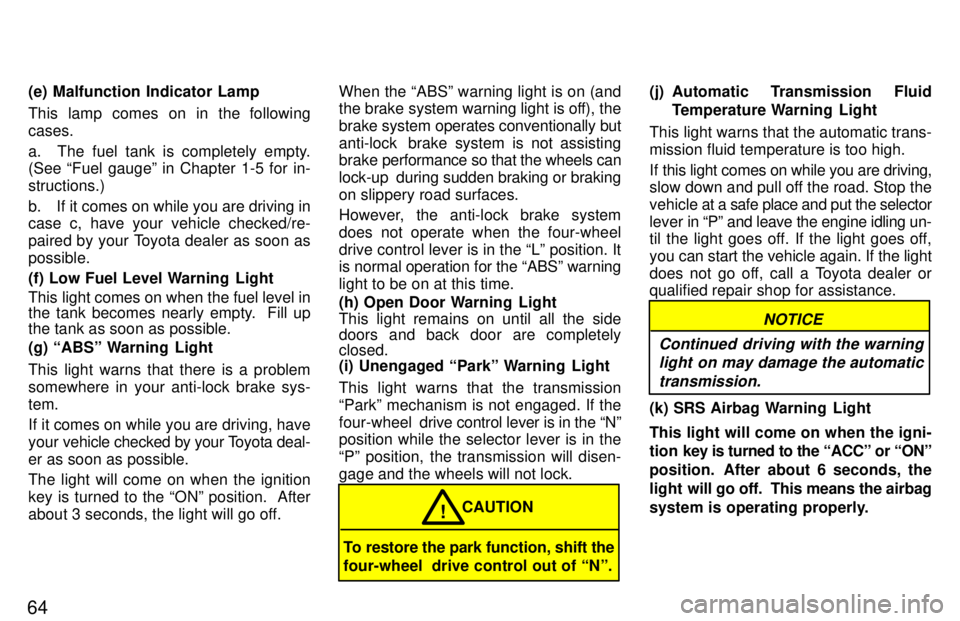
64(e) Malfunction Indicator Lamp
This lamp comes on in the following cases.
a. The fuel tank is completely empty. (See Fuel gaugeº in Chapter 1-5 for in- structions.)
b. If it comes on while you are driving in case c, have your vehicle checked/re-
paired by your Toyota dealer as soon aspossible.
(f) Low Fuel Level Warning Light
This light comes on when the fuel level in
the tank becomes nearly empty. Fill up the tank as soon as possible.
(g) ABSº Warning Light
This light warns that there is a problem
somewhere in your anti-lock brake sys-tem.
If it comes on while you are driving, have your
vehicle checked by your Toyota deal-
er as soon as possible.
The light will come on when the ignition
key is turned to the ONº position. After
about 3 seconds, the light will go off. When the ABSº warning light is on (and
the brake system warning light is off), the brake system
operates conventionally but
anti-lock brake system is not assisting brake performance so that the wheels can
lock-up during sudden braking or braking
on slippery road surfaces.
However, the anti-lock brake system
does not operate when the four-wheel
drive control lever is in the Lº position. It
is normal operation for the ABSº warning
light to be on at this time.
(h) Open Door Warning Light
This light remains on until all the side doors and back door are completely closed.
(i) Unengaged Parkº Warning Light
This light warns that the transmission
Parkº mechanism is not engaged. If the
four-wheel drive control lever is in the Nº
position while the selector lever is in the
Pº position, the transmission will disen-
gage and the wheels will not lock.
To restore the park function, shift the
four-wheel drive control out of Nº. CAUTION
! (j) Automatic Transmission Fluid
Temperature Warning Light
This light warns that the automatic trans- mission fluid temperature is too high.
If this light comes on while you are driving,
slow down and pull off the road. Stop the
vehicle at a safe place and put the selector
lever in Pº and leave the engine idling un-
til the light goes off. If the light goes off,
you can start the vehicle again. If the light
does not go off, call a Toyota dealer or
qualified repair shop for assistance.
NOTICE
Continued driving with the warning light on may damage the automatic
transmission.
(k) SRS Airbag Warning Light This light will come on when the igni-
tion key is turned to the ACCº or ONº
position. After about 6 seconds, the
light w ill go off. This means the airbag
system is operating properly.
Page 45 of 159
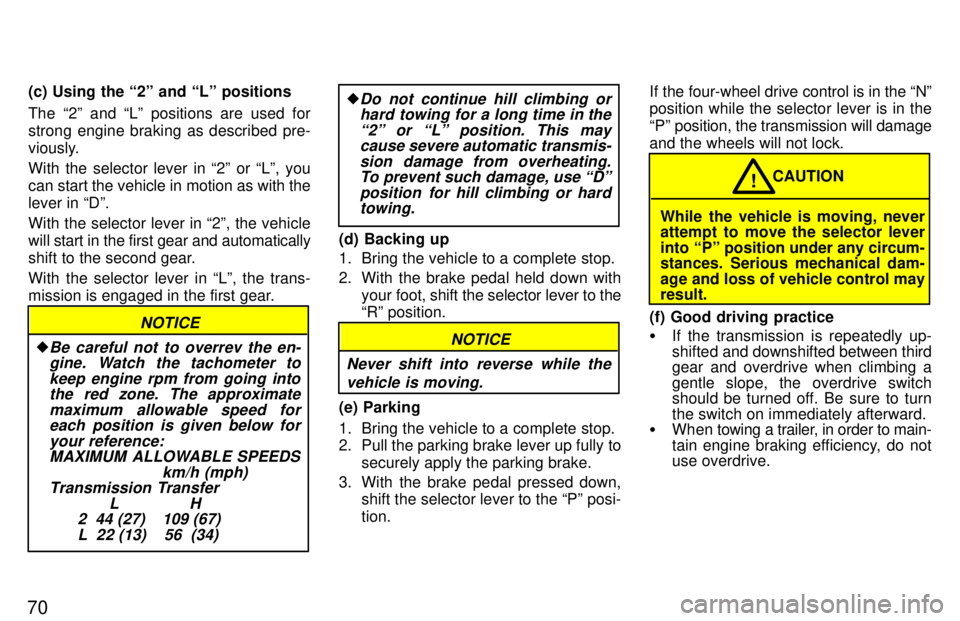
70(c) Using the 2º and Lº positions
The 2º and Lº positions are used for
strong engine braking as described pre-
viously. With the selector lever in 2º or Lº, you
can start the vehicle in motion as with the
lever in Dº. With the selector lever in 2º, the vehicle
will
start in the first gear and automatically
shift to the second gear.
With the selector lever in Lº, the trans-
mission is engaged in the first gear.
NOTICE
�Be careful not to overrev the en- gine. Watch the tachometer to
keep engine rpm from going intothe red zone. The approximate
maximum allowable speed foreach position is given below for
your reference:MAXIMUM ALLOWABLE SPEEDS
km/h (mph)
Transmission Transfer
L H2 44 (27) 109 (67)
L 22 (13) 56 (34)
�Do not continue hill climbing orhard towing for a long time in the
2º or Lº position. This maycause severe automatic transmis-
sion damage from overheating.To prevent such damage, use Dº
position for hill climbing or hardtowing.
(d) Backing up
1. Bring the vehicle to a complete stop.
2. With the brake pedal held down with
your foot, shift the selector lever to the
Rº position.
NOTICE
Never shift into reverse while the vehicle is moving.
(e) Parking
1. Bring the vehicle to a complete stop.
2. Pull the parking brake lever up fully to securely apply the parking brake.
3. With the brake pedal pressed down, shift the selector lever to the Pº posi- tion. If the four-wheel drive control is in the Nº
position while the selector lever is in the
Pº position, the transmission will damage
and the wheels will not lock.
While the vehicle is moving, never
attempt to move the selector lever
into Pº position under any circum-
stances. Serious mechanical dam-
age and loss of vehicle control may result.
CAUTION
!
(f) Good driving practice � If the transmission is repeatedly up-
shifted and downshifted between third
gear and overdrive when climbing a
gentle slope, the overdrive switch
should be turned off. Be sure to turn the switch on immediately afterward.
� When towing a trailer, in order to main-
tain engine braking efficiency, do not use overdrive.
Page 46 of 159
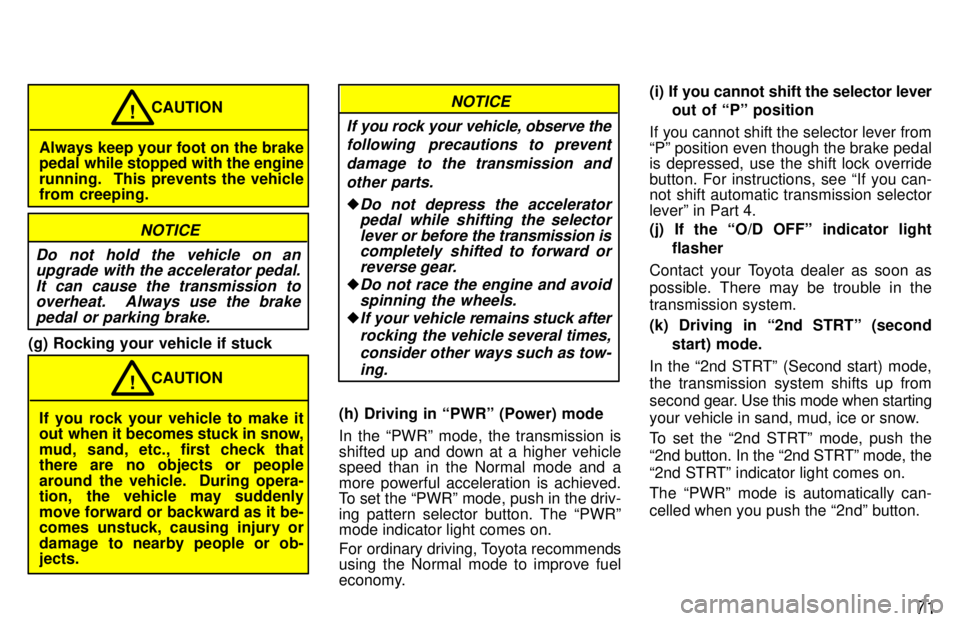
71
Always keep your foot on the brake
pedal while stopped with the engine
running. This prevents the vehicle
from creeping.CAUTION
!
NOTICE
Do not hold the vehicle on an upgrade with the accelerator pedal.
It can cause the transmission tooverheat. Always use the brake
pedal or parking brake.
(g) Rocking your vehicle if stuck
If you rock your vehicle to make it
out when it becomes stuck in snow,
mud, sand, etc., first check that there are no objects or people
around the vehicle. During opera-
tion, the vehicle may suddenly move forward or backward as it be-
comes unstuck, causing injury or
damage to nearby people or ob- jects. CAUTION
!
NOTICE
If you rock your vehicle, observe the following precautions to prevent
damage to the transmission andother parts.
�Do not depress the acceleratorpedal while shifting the selector
lever or before the transmission is
completely shifted to forward or
reverse gear.
�Do not race the engine and avoidspinning the wheels.
�If your vehicle remains stuck after
rocking the vehicle several times,consider other ways such as tow-ing.
(h) Driving in PWRº (Power) mode
In the PWRº mode, the transmission is shifted up and down at a higher vehicle
speed than in the Normal mode and a
more powerful acceleration is achieved.
To set the PWRº mode, push in the driv-
ing pattern selector button. The PWRº mode indicator light comes on.
For ordinary driving, Toyota recommends
using the Normal mode to improve fuel
economy. (i) If you cannot shift the selector lever
out of Pº position
If you cannot shift the selector lever fromPº position even though the brake pedal
is depressed, use the shift lock override
button. For instructions, see If you can- not shift automatic transmission selector leverº in Part 4.
(j) If the O/D OFFº indicator light flasher
Contact your Toyota dealer as soon as
possible. There may be trouble in the transmission system.
(k) Driving in 2nd STRTº (second start) mode.
In the 2nd STRTº (Second start) mode, the transmission system shifts up from
second gear. Use this mode when starting
your vehicle in sand, mud, ice or snow.
To set the 2nd STRTº mode, push the
2nd button. In the 2nd STRTº mode, the
2nd STRTº indicator light comes on.
The PWRº mode is automatically can-
celled when you push the 2ndº button.
Page 49 of 159
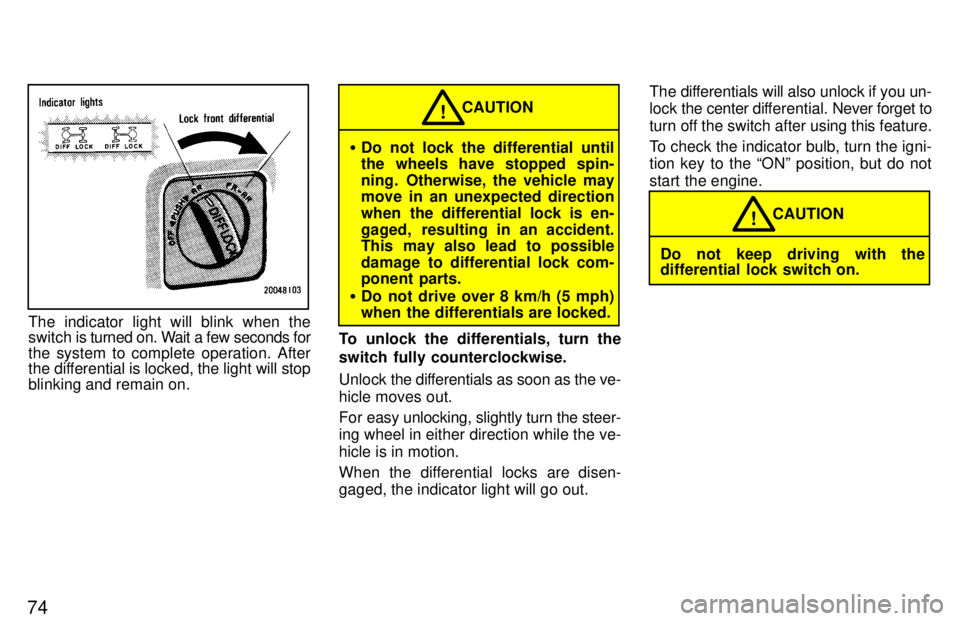
74
The indicator light will blink when the
switch is turned on. Wait a few seconds for
the system to complete operation. After
the differential is locked, the light will stop
blinking and remain on.
� Do not lock the differential until
the wheels have stopped spin-
ning. Otherwise, the vehicle may
move in an unexpected direction
when the differential lock is en-
gaged, resulting in an accident.
This may also lead to possible
damage to differential lock com-
ponent parts.
� Do not drive over 8 km/h (5 mph)
when the differentials are locked. CAUTION
!
To unlock the differentials, turn the
switch fully counterclockwise.
Unlock the dif ferentials as soon as the ve-
hicle moves out.
For easy unlocking, slightly turn the steer-
ing wheel in either direction while the ve- hicle is in motion.
When the differential locks are disen-
gaged, the indicator light will go out. The differentials will also unlock if you un-lock
the center dif ferential. Never forget to
turn off the switch after using this feature.
To check the indicator bulb, turn the igni-
tion key to the ONº position, but do not
start the engine.
Do not keep driving with the
differential lock switch on. CAUTION
!
Page 66 of 159

91
The track number you select is not valid if it is higher than the number of tracks re-
maining on the current cassette side. �
After the beginning of the tape is reached, the player will automatically
start playing the same side.
� After the end of the tape is reached,
the player will automatically revers
sides and start playing the other side.
There must be at least 3 seconds of blank
space between tracks for the track button
to work correctly. In addition, the feature
may not work well with some spoken word, live, or classical recordings. Compact Disc Player Push either side of the track button until
the number of the track you want to listen
to appears on the display. If you want to return the beginning of the current track,
push the down side of the button one time,
quickly. �� /��� (Reverse/Fast forward but-
tons)
Cassette Player Push the fast forward button to fast for-
ward a cassette tape. FFº will appear on
the display. Push the reverse button to re- wind a tape. REWº will appear on the dis-
play. To stop the tape while it is fast forwarding,
push on the up side of the track down/up
button or TAPEº; to stop the tape while it
is rewinding, push on the down side of the
track down/up button or TAPEº.
If a tape side rewinds completely, the ca-
sette player will stop and then play that
same side. If a tape fast forwards com-
pletely, the cassette player will play the
other side of the tape, using the auto-re- verse feature. Compact Disc Player
If you want to fast forward or reverse
through a compact disc track, push and
hold in the fast forward or reverse button.
When you release the button, the com-
pact disc player will resume playing. AM
VFM
Push AM VFMº to switch between the AM
and FM bands. AMº, FM1º or FM2º will
appear on the display. These systems al- low you to set twelve FM stations, two for
each button.
If the audio system is off, you can turn on
the radio by pushing AM VFMº. Also, push
the AM VFMº button to switch from cas-
sette or compact disc operation to radiooperation. BAL (Balance)
This knob lets you adjust the balance be- tween the right and left speakers. Push MID/BALº so that it pops out of its
retracted position. Pull out the knob. Turn
the knob to adjust the balance. Push theknob back into its retracted position. BASS
This knob lets you adjust the bass level.
Push BASSº so that it pops out of its re-
tracted position. Turn the knob to adjust
the bass. Push the knob back into its re- tracted position. CD (Compact Disc)
Push CDº to switch from radio or cas-
sette
operation to compact disc operation.
If the audio system is off, you can turn on
the compact disc player by pushing CDº.
In both cases, a disc must already be
loaded in the player.
When the audio is set into compact disc
operation, the display shows the track
number currently being played. Pushing CDº changes the display to show the
length of the current program being
played so far. By pushing the button once
again, the display returns to that of track
number.
Page 93 of 159
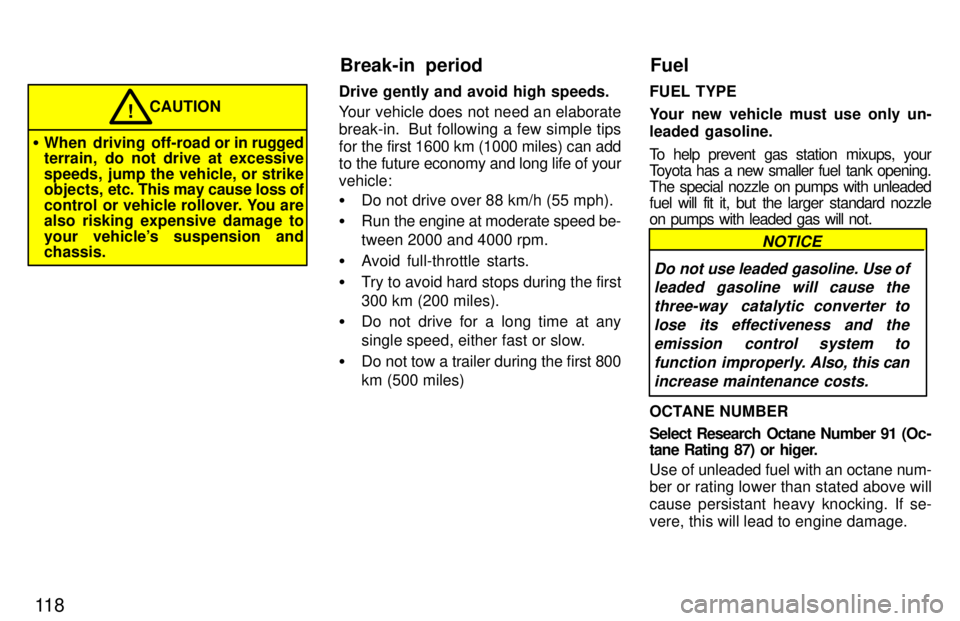
11 8
CAUTION!
� When driving off-road or in rugged
terrain, do not drive at excessive
speeds, jump the vehicle, or strike
objects, etc. This may cause loss of
control or vehicle rollover. You are
also risking expensive damage to
your vehicle's suspension and chassis. Drive gently and avoid high speeds.
Your vehicle does not need an elaborate
break-in. But following a few simple tips
for the first 1600 km (1000 miles) can add
to the future economy and long life of your vehicle: �
Do not drive over 88 km/h (55 mph).
� Run the engine at moderate speed be- tween 2000 and 4000 rpm.
� Avoid full-throttle starts.
� Try to avoid hard stops during the first
300 km (200 miles).
� Do not drive for a long time at any
single speed, either fast or slow.
� Do not tow a trailer during the first 800
km (500 miles) FUEL TYPE
Your new vehicle must use only un-
leaded gasoline.
To help prevent gas station mixups, your
Toyota has a new smaller fuel tank opening.
The special nozzle on pumps with unleaded
fuel will fit it, but the larger standard nozzle
on pumps with leaded gas will not.
Do not use leaded gasoline. Use of
leaded gasoline will cause the
three-way catalytic converter tolose its effectiveness and the emission control system tofunction improperly. Also, this can
increase maintenance costs.
NOTICE
OCTANE NUMBER
Select Research Octane Number 91 (Oc-
tane Rating 87) or higer.
Use of unleaded fuel with an octane num- ber or rating lower than stated above will
cause persistant heavy knocking. If se-
vere, this will lead to engine damage.
Break-in period Fuel
Page 98 of 159
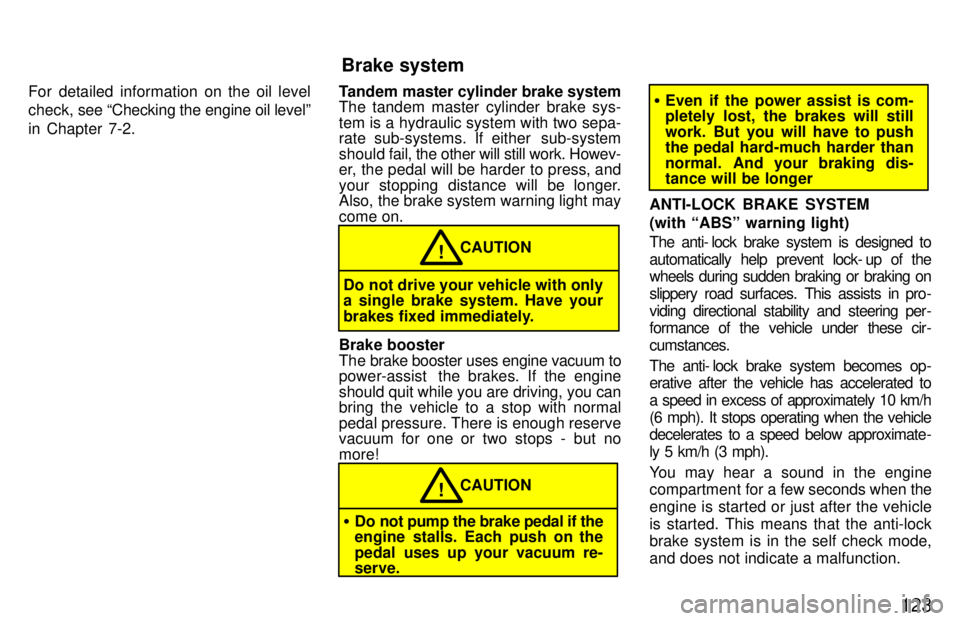
123
For detailed information on the oil level
check,
see Checking the engine oil levelº
in Chapter 7-2. Tandem master cylinder brake system
The tandem master cylinder brake sys-
tem is a hydraulic system with two sepa-
rate sub-systems. If either sub-system
should fa
il, the other will still work. Howev-
er, the pedal will be harder to press, and
your stopping distance will be longer.
Also, the brake system warning light may come on.
CAUTION!
Do not drive your vehicle with only
a single brake system. Have your
brakes fixed immediately.
Brake booster
The brake booster uses engine vacuum to
power-assist the brakes. If the engine
should quit while you are driving, you can
bring the vehicle to a stop with normal
pedal pressure. There is enough reserve
vacuum for one or two stops - but no more!
CAUTION!
� Do not pump the brake pedal if the
engine stalls. Each push on the
pedal uses up your vacuum re- serve.
�Even if the power assist is com-
pletely lost, the brakes will still
work. But you will have to push
the pedal hard-much harder than
normal. And your braking dis- tance will be longer
ANTI-LOCK BRAKE SYSTEM (with ABSº warning light)
The anti- lock brake system is designed to
automatically help prevent lock- up of the
wheels during sudden braking or braking on
slippery road surfaces. This assists in pro-
viding directional stability and steering per -
formance of the vehicle under these cir -
cumstances.
The anti- lock brake system becomes op-
erative after the vehicle has accelerated to
a speed in excess of approximately 10 km/h
(6 mph). It stops operating when the vehicle
decelerates to a speed below approximate-
ly 5 km/h (3 mph).
You may hear a sound in the engine
compartment for a few seconds when the
engine is started or just after the vehicle is started. This means that the anti-lock
brake system is in the self check mode,
and does not indicate a malfunction.
Brake system